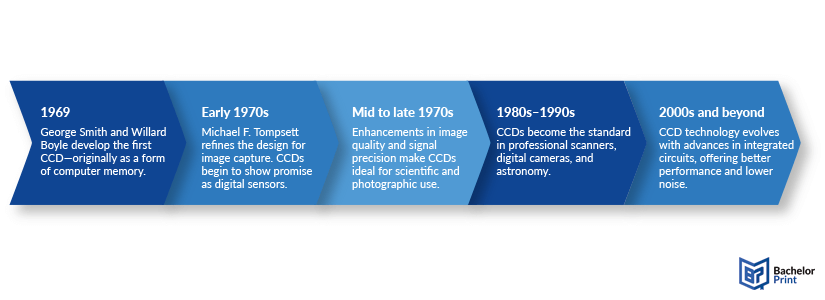
CCD is a printing term that refers to a high-precision image sensor commonly used in professional scanners. It plays a crucial role in accurately capturing documents, photographs, and artwork, laying the foundation for high-quality printed results. In this article, you’ll learn what a CCD is, how it works, where it’s used, and why it matters when it comes to achieving sharp, color-accurate prints.
Definition: CCD
A CCD (charge-coupled device) is an image sensor used in high-quality scanners and cameras. It captures detailed, accurate images, especially significant when the scan is intended for printing.
Here’s what you need to know:
✅ Known for precision, uniformity, and low noise compared to basic sensor types
✅ Light-sensitive chip that converts light (photons) into electrical signals (electrons)
✅ Used in professional-grade scanners and cameras to capture high-resolution images
Why does this matter for printing?
Because a good print starts with a good scan. This technology ensures:
- Accurate color reproduction
- Even lighting with no shadow distortion
- Crips fine details, like small fonts or textures
Note: If you’re scanning something to print, like a photo, document, or artwork, a CCD scanner gives your file the clarity and quality needed for excellent print results.
To understand how this technology became so powerful, it helps to look at how the underlying integrated circuits have evolved.
SSI
(Small)MSI
(Medium)LSI
(Large)VLSI
(Very large)ULSI
(Ultra large)
10 – 100 transistors per chip
100s – 1,000 transistors per chip
1,000 – 100,000 transistors per chip
≤ 1 million transistors per chip
Millions – billions transistors per chip
Digital watch
Calculators
Microprocessors
Modern CPUs
Smartphones
History
The charge-coupled device was invented in 1969 at Bell Labs by engineers George Smith and Willard Boyle. Originally intended as a new form of computer memory, the breakthrough came when Michael F. Tompsett, also at Bell Labs, refined the concept to make it suitable for image capture.
Throughout the 1970s, further development greatly improved the CCD’s light sensitivity and image quality, making it a powerful tool for digital imaging. As a result, they quickly became the leading technology in professional photography, scientific imaging, and high-end scanning.
Over the years, CCDs have evolved alongside advancements in integrated circuits, from small-scale integration (SSI) to very-large-scale integration (VLSI), leading to higher performance and lower noise, both critical for quality scanning and printing.

Certificate printing at BachelorPrint
- Choose from fine papers with premium finishes
- Custom certificate printing for any occasion from AU$0.16
- Celebrate achievements & awards with elegant certificates
Learn more!
What does it do?
A CCD scanner is designed to capture high-quality digital images of physical documents, photos, and other originals. While it works behind the scenes with advanced sensor technology, what really matters is what you get from it.
You’ll notice the difference in
No dark edges, shadows, or uneven brightness, just a clean, well-balanced scan across the entire surface. This ensures all areas of the document or image are equally visible and print-ready.
CCD scanners capture colors with high precision, preserving true-to-original tones and subtle gradients. This is essential for reproducing photos, certificates, and any documents where color matters.
Small fonts, fine lines, and intricate patterns are rendered with clarity. This is especially useful for documents, hand-drawn elements, or any design with detailed structures.
Whether the original has folds, curves, or a rough surface, a CCD scanner can capture it without distortion. Even non-flat materials come through cleanly and clearly.
Whether you’re scanning a photo to reprint it or uploading a document for digital archiving, a CCD ensures the scanned image is a high-quality base for professional printing.
How does it work?
The scanner turns light into digital information, capturing every detail of your original so it can be printed with precision. Here’s how it works in three simple steps:
Step 1: Light illuminates the original
A light source inside the scanner shines evenly across the surface of your document or photo. This reflected light carries all the visual information (colors, textures, and details).
Step 2: Light hits the CCD sensor
The reflected light is directed through a lens or mirrors onto the CCD sensor. The sensor is made up of thousands (or millions) of light-sensitive pixels that detect brightness and color.
Step 3: Electrical charges are generated
Each pixel reacts to the incoming light by storing a small electrical charge. Brighter areas create stronger charges, while darker areas generate weaker ones.
Step 4: The image is digitally assembled
These stored charges are then transferred, one by one, and converted into digital signals. The result is a high-resolution digital image that reflects the original with great accuracy, ready to be processed and printed.
⇨ The result is a scanned image that looks almost exactly like the original.
This level of precision is also why CCD scanners are often used for producing faithful facsimiles of rare or historical originals.
CCD vs. CMOS sensors
Both CCD and CMOS are types of image sensors used in scanners and cameras. While they serve the same basic purpose, they differ in quality, cost, and typical use.
Here’s how they compare
CCD
CMOS
Cost
Higher
Lower
Quality
Excellent
Moderate
Used in
Lighting
Even and smooth, no shadowing
Uneven lighting or dark corners
Performance
Handles folds, curves, and textures very well
Struggles with anything not completely flat
Color accuracy
Very high
Lower
Examples
CCD scanners are most valuable when detail, clarity, and color accuracy truly matter. Here are some real-world scenarios where this technology shines:
CCD handles wrinkles, folds, and uneven surfaces without shadowing or distortion.
CCD ensures sharp reproduction, maintaining the original layout, text, and color fidelity.
The scanner preserves fine text, seals, and signature details even on textured or aged paper.
The sensor captures subtle color gradients and brush textures faithfully.
Why it matters
When it comes to printing, the quality of your scan is just as important as the quality of your printer paper or printer. A blurry or uneven scan can’t be fixed later, not even with the best type of printer.
Better input = better print
A high-quality scan, especially from a CCD sensor, can make a visible difference:
- Even lighting (no shadows or fading near the edges)
- More accurate colors (ideal for photos, artwork, and logos)
- Sharper text and lines (great for documents, theses, and forms)
Why is it worth knowing?
These scanners are often used in professional printing and archiving environments because they provide:
✅ Reliable image quality
✅ A solid base for sharp, true-to-original prints
✅ Consistent results, even from non-perfect originals
Note: Whether you’re printing from a digital file or a scanned document, starting with a high-quality scan can have a big impact on the final result.
High-quality color copies from just AU$0.28
- Choose from different paper formats & paper weights
- Configure finishing options & add any extras you need
- Easy online ordering process with delivery to your doorstep
Learn more!
Benefits & weaknesses
CCD scanners offer clear advantages when it comes to image quality, but like any technology, they also come with trade-offs.
Pros
- High dynamic range
- Sharp detail capture
- Even, consistent lighting
- Excellent color accuracy
- Better for high-end applications
- Great for scanning imperfect originals
- Handles folds, textures, and curves well
Cons
- Higher power consumption
- Pricier than standard scanners
- Slower scanning speed due to readout
- Moving parts, so higher chance of wear
- Requires calibration for optimal results
- Bulkier design that takes up more space
- Not typically found in home/office devices
FAQs
A CCD scanner uses a charge-coupled device to capture images of physical originals. It’s known for producing sharp, color-accurate, and evenly lit scans, making it ideal for high-quality printing.
Yes, these sensors are still used, especially in professional scanning, art reproduction, and archiving where image quality is more important than speed or cost.
In simple terms: light hits the sensor, which collects electrical charges that are then converted into a high-resolution digital image which is ready for printing.
Not necessarily. For scanning flat, detailed documents or photos, the scanner delivers more consistent sharpness and lighting than a digital camera.
CCDs are often used in high-end scanners, photo reproduction, archival scanning, and facsimile production, where image accuracy really matters.
They’re typically found in larger, more expensive equipment, and they can be slower than standard sensors like CMOS. However, the image quality is usually superior.